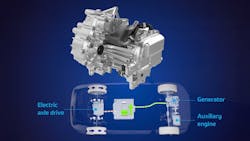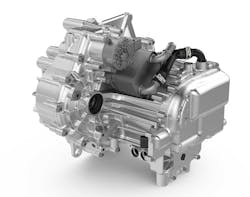ZF's Range Extender Technology: New Developments
What you'll learn:
- Range extender systems are power-generating systems consisting of an electric motor and inverter that increase electric-vehicle range.
- How do range extender systems stack up against plug-in hybrid systems?
- Advantages for automotive manufacturers: Shorter development cycles, less effort due to the platform approach.
A range extender EV system (REEV) essentially consists of an additional electric motor that acts as a generator, an inverter for voltage conversion and a small combustion engine that powers the generator, which in turn charges the high-voltage battery whenever needed. While it primarily caters to the needs of Chinese electric car manufacturers, it also has the potential to boost the electric mobility markets in Europe and North America.
With range extenders, a combustion engine is coupled to an electric machine that generates power for the vehicle battery as soon as its state of charge drops below a certain threshold. This increases the range that can be driven electrically.
The advantage compared to plug-in hybrid (PHEVs) or conventional combustion engines: The range extender machine always runs in the ideal performance range for fuel consumption. This helps ensure low fuel consumption and, therefore, also lowers CO2 emissions.
REEVs vs. PHEVs
Like PHEVs, range-extended EVs also have a socket for charging, but they feature on-board power generation, too. It recharges the drive battery while on the move, which means the battery can be smaller — and, in turn, reduces vehicle weight and the purchase price. In addition, the drive technology in an EV with a range extender is simpler than that in a plug-in hybrid, speeding up development times.
Compared to parallel-hybrid drive solutions, for example with a PHEV, range extenders are compelling due to their lower additional costs, shorter development cycles, minimized platform effort, and simplified supply-chain management. This makes the technology particularly interesting for manufacturers new to the market and perhaps little experience with traditional combustion engine drivelines.
According to ZF AG major manufacturers such as Ford, Hyundai, and Stellantis are said to be showing interest in range extender technology. They’re planning to launch vehicles equipped with it within the next two years.
In its traditional form, a range extender EV is a series hybrid where propulsion is purely electric. Neither the small internal combustion engine nor the associated electric motor drives the wheels. Only the PHEV offers the choice between electric and internal combustion engine during driving. Both drive concepts drastically reduce CO2 emissions.
Another similarity between REEVs and PHEVs is that their potential range makes them equally suitable for regions with less developed charging infrastructure.
A New Version: The Modular Range Extender Drive
ZF has now advanced the technical concept of the range extender. It’s working on a modular range extender drive called the "electric Range Extender" (eRE) and the "electric Range Extender plus" (eRE+). The common traits between the ZF eRE and eRE+ are that they can be used in vehicles with a system voltage of 400 or 800 V, and that they’re flexible in terms of semiconductor type — it doesn’t matter whether a customer uses traditional silicon semiconductors or silicon-carbide (SiC) types.
The eRE combines an electric motor with an integrated inverter, suitable software, and a planetary gearbox. The eRE+ also has an intelligent clutch and a differential. Thus, it can be used either as a power generator or an additional secondary drive, which saves manufacturers from having to develop a separate component. The power can be scaled for both models. The output ranges from 70 to 110 kW (eRE) or 70 to 150 kW (eRE+).
ZF has already launched range extender technology in volume production. Among other things, ZF's electric machines were installed in a series of London taxis.
"We recognized the advantages of range extenders early on and equipped the first electric taxis in London with them back in 2018. Now, we are offering a modular solution that significantly reduces the carbon footprint compared to PHEVs," said Kay Schmidt, responsible product line manager for range extender systems at ZF.
"Although the all-electric range of passenger cars is around 500 km on average, range anxiety still influences a wide range of buyers when choosing their next vehicle," noted Dr. Otmar Scharrer, ZF Senior Vice President R&D, Electrified Powertrain Technology. This is especially true in regions where a charging infrastructure isn’t yet universally available.
Advantages for Manufacturers
China is currently embarking on a model offensive of REEVs, which, thanks to the technology, can cover distances of more than 700 km. In November 2023, ZF began developing its modular range extender system eRE at its tech center in Shanghai.
"This is where we find it convenient that there is a wide range of BEV platforms that can be supplemented by range extenders," said Scharrer. It’s another reason why the Chinese ZF locations were in charge of development.
Other advantages of ZF's range extender are its compact dimensions and straightforward installation on the internal combustion engine. The compact design is further enhanced by integrating the inverter into the housing of the electric motor. Volume production is scheduled to begin in 2026.

